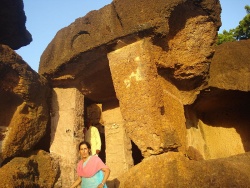Dharmrajeshwar
Dharmrajeshwar (Hindi: धर्मराजेश्वर) is an ancient Buddhist and Hindu cave temple site of 4th-5th Century in Mandsaur district in Madhya Pradesh, India.
It is an example of Indian rock-cut architecture, situated in Garoth tahsil of Mandsaur district at a distance of 4 km from Chandwasa town and 106 km from Mandsaur city.
Nearest railway station is Shamgarh about 22 km. Its original name is Dhamnār (धमनार).
Dharmarajeshwara temple
It has the 9th century monolithic temple of Dharmarajeshwara, carving it out of solid natural rock.
The temple is carved out of a rock of size 50 metre in length, 20 metre in width and 9 metre deep.
It has a sanctum with a Sabhamandapa and porch. The spire of the shrine is in the north Indian style.
The architecture of Dharmarajesvara temple can be compared with Kailash Temple of Ellora.
There is a big temple in the middle 14.53 metre in length and 10 metre in width.
Around the main temple there are seven small temples.
There is a big Shivalinga in the main temple along with a statue of Vishnu.
Engraved on the entrance gate are figures of Vishnu and Lakshami.
There are statues of Bhairava, Kali, Shiva, Garuda and Parvati.
The temple seems to be devoted to both Shiva and Vishnu.
A grand fair is organized at Dharmrajeshwar temple on the occasion of Shivaratri every year when large number of people gather from the nearby areas.
The town Chandwasa itself also contains an old medieval temple which was later on destroyed and converted into a patchwork mosque, its door-frame finding place in the Museum at Indore.
Rock-cut caves Dhamnar
The most important and interesting monuments at Dhamnar are the Rock cut caves and temples.
They are cut into the coarse laterite rock of the southern hill.
There is a series of fourteen the 7th century rock-cut Buddhist Caves with monasteries and Stupas, cut in a hill called Chandanagiri in ancient times and giving its name to the neighbouring town of Chandwasa (Chandanavasa).
A Stone Wheel for Mortar making at Dharmrajeshwar
These caves were first noticed by James Tod who gave a number of caves to be 170 and indicated them to be belonging to Jain culture.
He identified five statues as those of tirthankaras: Rishabhadeva, Neminath, Parshavanath, Shantinath and Mahavira.
The local people consider these statues to be of the five Pandavas.
Later these were visited by Alexander Cunningham, Ferguson and Henry Kajins who disagreed with Tod. Dr Ferguson counted number of caves to be 60-70. Alexander Cunningham was also in agreement with Dr Ferguson. Ferguson considers the period of construction of caves from 408-475 AD.
The important caves at Dhamnar are as under:
- }Badi kachahariChhoti kachahariKamini mahal or RajlokBhim BazarHathi bandhiChhota Bazar - Cave number 6 is known by the name of kachahari.
There is a grand mandapa on four pillars in the cave. chatya is in the back. Badi kachahari is a large chaitya hall with pillared portion ::in front enclosed by a stone railing.
- Chhoti kachahariKamini mahal or Rajlok - Cave number 8 is known by the name of Chhoti kachahari.
- Kamini mahal or Rajlok - Cave number 11 is known by the name of Kamini mahal or Rajlok.
- Bhim Bazar - Cave number 1 is known by the name of Bhim Bazar. it is the largest of Dhanmar caves.
It consists of an open porch or vrandah ::with a couple of rooms in the rear.the rectangular court has a chaitya in the centre enclosed on three sides by rows of small cells each side having ::a smaller chapel in the central cell.
The sculptures include seated Buddhas.
- Hathi bandhi - Cave number 12 is known by the name of Hathi bandhi.
- Chhota Bazar - Cave number 13 is known by the name of Chhota Bazar.
This is considered best of all the caves.
In a big hall in north of this ::cave is a small devalaya in which is housed an 8 feet high statue of Buddha.
